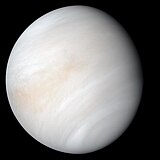Datoteka:PIA23791-Venus-RealAndEnhancedContrastViews-20200608 (cropped).jpg

Veličina ovog prikaza: 600 × 600 piksela. Ostale rezolucije: 240 × 240 piksela | 480 × 480 piksela | 768 × 768 piksela | 1.096 × 1.096 piksela.
Izvorna datoteka (1.096 × 1.096 piksela, veličina datoteke: 30 KB, MIME tip: image/jpeg)
Historija datoteke
Kliknite na datum/vrijeme da vidite verziju datoteke iz tog vremena.
| Datum/vrijeme | Smanjeni pregled | Dimenzije | Korisnik | Komentar | |
|---|---|---|---|---|---|
| trenutno | 00:40, 10 juli 2020 |  | 1.096 × 1.096 (30 KB) | PhilipTerryGraham | File:PIA23791-Venus-RealAndEnhancedContrastViews-20200608.jpg cropped 51 % horizontally using CropTool with precise mode. |
Upotreba datoteke
Sljedeća stranica koristi ovu datoteku:
Globalna upotreba datoteke
Sljedeći wikiji koriste ovu datoteku:
- Upotreba na ary.wikipedia.org
- Upotreba na arz.wikipedia.org
- Upotreba na ast.wikipedia.org
- Upotreba na as.wikipedia.org
- Upotreba na awa.wikipedia.org
- Upotreba na azb.wikipedia.org
- Upotreba na az.wikipedia.org
- Upotreba na ban.wikipedia.org
- Upotreba na bat-smg.wikipedia.org
- Upotreba na ba.wikipedia.org
- Upotreba na bcl.wikipedia.org
- Upotreba na be-tarask.wikipedia.org
- Upotreba na be.wikipedia.org
- Upotreba na bew.wikipedia.org
- Upotreba na bg.wikipedia.org
- Upotreba na bh.wikipedia.org
- Upotreba na bjn.wikipedia.org
- Upotreba na bn.wikipedia.org
- Upotreba na bo.wikipedia.org
- Upotreba na br.wikipedia.org
- Upotreba na btm.wikipedia.org
- Upotreba na bxr.wikipedia.org
- Upotreba na ca.wikipedia.org
- Upotreba na cdo.wikipedia.org
- Upotreba na ceb.wikipedia.org
- Upotreba na ce.wikipedia.org
- Upotreba na chr.wikipedia.org
- Upotreba na ckb.wikipedia.org
- Upotreba na co.wikipedia.org
- Upotreba na crh.wikipedia.org
- Upotreba na cr.wikipedia.org
- Upotreba na csb.wikipedia.org
- Upotreba na cs.wikipedia.org
- Upotreba na cu.wikipedia.org
- Upotreba na cv.wikipedia.org
- Upotreba na cy.wikipedia.org
- Upotreba na dag.wikipedia.org
- Upotreba na da.wikipedia.org
- Upotreba na de.wikipedia.org
- Upotreba na dga.wikipedia.org
- Upotreba na din.wikipedia.org
- Upotreba na diq.wikipedia.org
- Upotreba na dsb.wikipedia.org
- Upotreba na dty.wikipedia.org
- Upotreba na el.wikipedia.org
- Upotreba na eml.wikipedia.org
Pogledajte globalne upotrebe ove datoteke.



